Since we first wrote this article, a lot has changed, and each of the tools has made progress. This version was written has the latest versions of each of the tools, and our latest choices for the best.
So, you’re ready to build out a new site, and you want to give it all the bells and whistles…but you’re not sure what to use?There’s so many options out there, from hosting something on your own with WordPress or Drupal, to services like Duda, Wix, WordPress.com, Squarespace, and Weebly. They all have benefits and drawbacks, and the decision can be complicated.What should you do? Well, here at Siteturner, we want to help. So we’ve spent hundreds of hours testing each platform, and now we’re putting them head to head.

In today’s comparison, we’re looking at the hosted services, WordPress.com, Duda, Wix, and Weebly. In a future comparison, we will compare these with SquareSpace and a few other website builders. And later, for those of you who are experts, we will compare these hosted services against hosting WordPress or Drupal yourself.
Before we get started, here’s the table of contents in case you want to skip to a particular section of this (long) review.
Table of Contents
- 1. What are Duda, Wix, Weebly, and WordPress
- 2. What we’re comparing
- 3. Duda vs WordPress vs Wix vs Weebly: Comparison
- 4. Wix vs WordPress vs Duda vs Weebly: Ease of use
- 5. WordPress vs Wix vs Weebly vs Duda: Quality
- 6. Weebly vs Duda vs WordPress vs Wix: Pricing
- 7. So what’s the best value?
- 8. Conclusion
Phew…now that that’s done, let’s get started with the actual review.
1. What are Duda, Wix, Weebly and WordPress
Before beginning the comparison, let’s take a deeper look at what Duda, Wix, Weebly, and WordPress are. Let’s start with Duda.
Duda: an introduction
 Duda is a service that was originally designed for creating mobile websites from desktop sites. It has two different modes: a responsive mode and a mobile website mode.
Duda is a service that was originally designed for creating mobile websites from desktop sites. It has two different modes: a responsive mode and a mobile website mode.
The mobile website mode allows you to create a mobile website out of a standard desktop site. In this mode, you enter a website URL and Duda tries to take that website and turn it to a phone-friendly version. The success with which it does that varies, and we’ll look at that more in depth later.
The other mode allows you to build a responsive website by choosing a template and then adding widgets. This mode more directly competes with WordPress, and can be very useful, as we will find out.
Weebly: an introduction
 Weebly is a well known eCommerce and website building solution that is now part of Square.
Weebly is a well known eCommerce and website building solution that is now part of Square.
More recently, Weebly has split into two product lines: the original Weebly tool for making non-ecommerce sites, and a new Square tool for making e-commerce sites. They have hidden a lot of the excellent e-commerce functionality that they had in the original Weebly tool in order to promote the Square tool.
WordPress: an introduction
 WordPress is the most well known of all content management services, and it’s in use by an estimated 25% of all of the websites on the Internet.
WordPress is the most well known of all content management services, and it’s in use by an estimated 25% of all of the websites on the Internet.
Like Duda, WordPress also has two different modalities. You can install the open source platform on your web server, or you can go to WordPress.com and build a site online. The latter is a direct competitor to Duda, while the former is an indirect competitor.
In this article, we will mostly be looking at the online version, WordPress.com (which we will refer to simply as WordPress from here on), although much of the comparison is transferable. We will look into the difference between self-hosting WordPress and using the online version in a later article.
Wix: an introduction
 Wix was started back in 2006, making it almost as old as WordPress (but not quite). You’ve probably seen the commercials for Wix, since they’re on all the time. This is a more mature product than Duda (and even Weebly), but it’s not quite as innovative anymore.
Wix was started back in 2006, making it almost as old as WordPress (but not quite). You’ve probably seen the commercials for Wix, since they’re on all the time. This is a more mature product than Duda (and even Weebly), but it’s not quite as innovative anymore.
There are multiple modes of service, including a drag and drop type builder, an (essentially) automatic site designer, and a coding option for advanced users.
Wix has a very large ecosystem of developers, who provide additional functionality for the service.
2. What we’re comparing
In comparing Wix, Duda, Weebly and WordPress, we will look at the following variables:
Ease of use
How easy is it to set up the platform? How easy is it to build a complete website? How easy is it to make changes to the website?
Quality
Quality is comprised of functionality, design, and performance:
- Design – How good will the website you created look? Are the colors complementary, or do they clash? Are fonts uniform? Do new widgets or elements that are added to the site match the current ones?
- Functionality – How much functionality is available? For example, can you connect your site to different data sources? How comprehensive are the editing options? What about permissions and multiple users in an organization? What plugins/apps are available?
- Performance – Performance is comprised of two major categories. First is speed and page optimization: how well will your website perform? This is an important factor in search engine rankings, and you will turn users off if your site is too slow. Second is mobile performance. It’s all about mobile these days. Google has implemented its mobile-first indexing for many sites (meaning that Google is only looking at the mobile version of your site when determining rankings), and mobile traffic makes up more than half of all Internet traffic. So your site had better work well on mobile.
Pricing and Cost
Price is of course extremely important; however, what’s more important is total cost. For instance, you can download the entire WordPress source code and install it on your home computer for free — but when you add in the cost of installation, tech support and bandwidth, you’re in for thousands of dollars.
3. Duda vs WordPress vs Wix vs Weebly: Comparison
General functionality comparison
WordPress |
Wix |
Duda |
Weebly |
|
|---|---|---|---|---|
| Try it | Try it | Try it | Try it | |
| Available themes | Any WordPress theme for business plans, ~300 built in | ~30 for the basic designer, hundreds for the advanced, 1 for store | Hundreds | ~40 |
| Free plan | Free vanity subdomain (note, you need to buy a business level plan to remove their branding) | Subdomain on wixsite.com | Subdomain on multiscreensite.com | Subdomain on weebly.com |
| SEO Functionality | SEO tools for business plans only | SEO wizard included | Basic SEO built in | Basic SEO built in |
| Import options | Self hosted WordPress, Medium, Tumblr, Wix, Squarespace, Blogger, more | Connects to your website and social to import (some) content | Imports some content from website | None |
| Export options | Basic data export | None | HTML and assets* | None |
| No branding on website | Ads removed; branding removed for business plans | For all plans | For all plans | For all plans |
| Reporting, analytics functionality | Basic analytics built in via JetPack | Built in | Basic analytics built in | Basic analytics built in |
| Google Analytics | Only for business plans | Suported* | Fully supported | Install manually |
| Social media integration | Dozens of integrations, more by plugin | Available via apps, dashboard tool | Available via apps | Available via apps |
| Storage | 6-13 GB for personal plans, 200GB for business | 3+, depending on plan, unlimited on top plan | Unlimited | Unlimited |
| Support | Email, live chat* | Email, chat, phone | Email, chat, phone* | Email, chat, phone |
| Plugins | Several hundred plugins available; can upload additional* | Free and paid 3rd party apps available | Several rules, plus ~50 apps | 350+ free and paid third party apps |
| Comments | Full featured comments built in | Built in | Third party (Facebook, Disqus) | Built in |
| Membership | Available via third party plugin | Built in, including registration, social, profiles, posts | Available by app | Basic features included, additional features via third party apps |
| Project management or collaboration tools | Available via third party plugin | Workflow tools included | Included on certain plans | Not available |
| Booking functionality | Available via third party plugin | Full featured booking built in | Built in | Available via third party (mostly paid) apps |
| Marketing tools | Built in for top plan | Dozens of tools built in | Built in | Available at an additional charge |
| Advertising | Built in for most plans | Multiple options built in | Ads via third party apps | Ads via third party apps |
| GDPR Compliance | Some GDPR tools, cookie consent widget available | GDPR tools available | Tools: privacy page, cookie notifications, IP masking, opt-in notification for forms | Cookie opt out, EU visitors can block data |
* Available on certain plans
eCommerce functionality comparison
WordPress |
Wix |
Duda |
Weebly |
|
|---|---|---|---|---|
| Try it | Try it | Try it | Try it | |
| Adding products | CSV, Manual, Plugins to import from many other products | Manual entry, CSV | Manual entry, import from CSV, XCart, LiteCommerce | Auto sync with Square, manual entry, import from CSV, stores |
| Fulfillment options | Some automatic, manual | Full automatic and manual + dropship + Amazon | Some automatic, manual | Automatic rates from UPS, Fedex, USPS, DHL, manual rates* |
| Payment processing options | Hundreds supported, some cost extra | Square, Paypal, Wix, Braintree, Stripe, and several more | Square, Paypal, Stripe, and several more | Square, Paypal, Google Pay, Apple Pay, more |
| Buyer customization options | Basic, additional features available via plugins | Customize products, multiple variants | Multiple variants, customize products | Customize products, multiple variants |
| Inventory management | Available via plugins, some cost extra | Track inventory | Track inventory* | Track inventory* |
| User reviews | Built in | With plugin | Not available | User reviews supported* |
| Additional sales channel options | Available via plugins | Several available | Facebook, Instagram, Amazon, Google* | Tiktok, Facebook, Google |
| Transaction fees | Just the processor fees | Just the processor fees (incl. Wix processor fee) | Just the processor fees | 2.6-2.9% + $0.30 |
* Available on certain plans
Performance comparison
No matter how nice your site looks, it’s useless if people decide to leave because it’s taking too long to load. Additionally, Google uses page load speed as part of its formula in determining search engine page ranking. So it’s absolutely vital that your site loads relatively quickly.
In order to test performance, we decided to use Google’s PageSpeed test suite on Wix, Weebly, Duda, and WordPress. In terms of methodology, we used skeleton sites created with each product. We chose a template at random, and then immediately published the site, and ran the page speed test on it. We did this multiple times, with different templates, and took the average scores.
Obviously, this methodology isn’t a perfect measure of how well your site will perform. However, it gives a good baseline to determine how well you can expect a site to perform on each platform.
Test results
In test results, all of the products in our review did relatively well. WordPress performed the best, but it’s important to note that much of its excellent performance is due to the fact that the available WordPress templates and features tend to be less graphical (and less attractive) than its competitors.
More interesting is the fact that Duda came in second, receiving nearly as high a score, even though its templates and designs are much more graphical, and filled with animations, widgets, and CSS transitions.
Since we first ran this metric, there has been enormous improvement. In fact, WordPress is now down to 2.6 seconds before interactive, a huge jump in usability. Duda has also shown improvement, as has Weebly. The only one that did worse is Wix.
WordPress |
Wix |
Duda |
Weebly |
|
|---|---|---|---|---|
| Try it | Try it | Try it | Try it | |
| Speed score Higher is better | 95 | 7 | 82 | 47* |
| First paint Lower is better | 2.1 sec | 3.2 sec | 2.2 sec | 4.3 sec* |
| Time to interactive Lower is better | 2.6 sec | 34.4 sec | 5.2 sec | 8.2 sec* |
* For the Weebly only site; the Square site scores lower
4. Wix vs WordPress vs Duda vs Weebly: Ease of use
WordPress: Ease of use
Getting started with WordPress is really simple. You go to the WordPress.com website and register, then you enter a few questions.
From there, you’re asked to choose a site URL, and at that point you’re asked to sign up for a paid version, which allows you to get a free domain name.
Once your site has been created, you will see a sort-of wizard that helps you get your site published. The wizard will walk you through choosing an icon from the site, and adding a tagline.
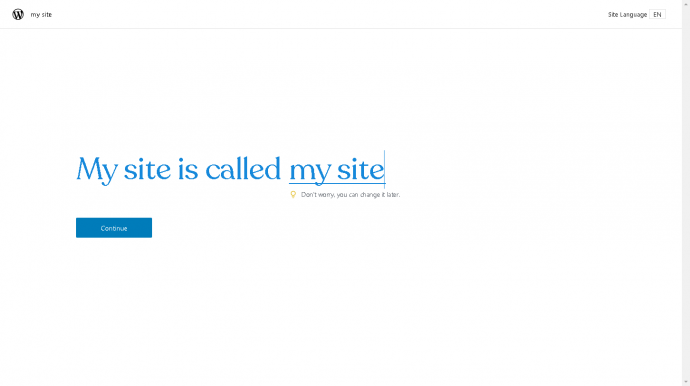
WordPress has made great strides in usability since we first reviewed it. Walking through the process, you are no longer confused. After creating a site, you’re immediately taken to the latest Gutenberg editor, which is clean and easy to use.
There is no longer a white page; instead, you get a complete WYSIWYG view of the site, which is all editable. Now, instead of a complicated process, you simply click on a title or paragraph to edit it.

Last time we did this test, several of our testers got confused at this point, because they were faced with some widget code. However, that’s long gone, and this time, nobody was confused.
The best thing about this new version of WordPress.com is that a lot of the complexity of WordPress is hidden from novice users, but still available if you need it. When you’re editing your site, you see a very stripped-down version of the WordPress menu bar:

However, you can always expand and go to the full menu bar, so regular WordPress users can access all of the functionality that they expect.
Building a store with WordPress
WordPress doesn’t actually have a built-in eCommerce solution. Instead, it allows you to use WooCommerce with a one-click install.
For those of you who don’t know, WooCommerce is the most widely used WordPress eCommerce plugin. It’s used by hundreds of thousands of sites online, from small sites to enormous ones, so you’ll always be able to find help and support.
The great thing about WooCommerce is there are addons for nearly anything you can imagine, so you will almost certainly be able to build a store around your specific use case, no matter how complicated it is.
However, there is a downside to WooCommerce. The plugin is not particularly easy to use for newbies. Since there are so many features and options, it takes quite a bit of experience to get everything set up and running properly.
Duda: Ease of use
Getting a nice looking website up and running is pretty easy with Duda, but there can be some little quirks that make building your perfect site a bit more complicated.
When you start your website with Duda, the first thing you do is choose website type. Then, you choose a template. There are hundreds of different templates to choose from, including dozens of business templates.
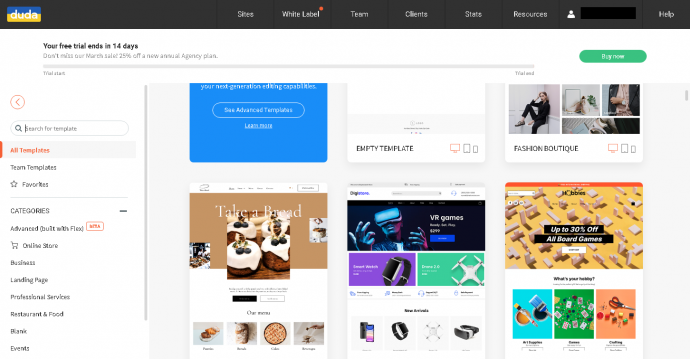
Once you have chosen a template, you simply enter the name of your site, and the system puts together a site for you, which you customize using a drag and drop GUI editor.
Duda’s site editor is arguably the most graphical of all of the products in this article. For those who are familiar with a tool like PowerPoint, it’s pretty easy to get a hang of how to add and format design elements. All you need to do to add an element is select it from the widgets menu on the side bar, and drag it onto the page.
Building a store with Duda
Building a store on Duda is pretty straightforward. You can enter your products, or import them, and then the system does most of the work. We found everything to be pretty self-explanatory. There are several payment options, including Square, Paypal, and Stripe, and automated shipping calculation.
Duda shops integrate with Facebook, Instagram, Google, and even Amazon, so you can sell there too — if you have the right level plan. There are pretty good analytics included free, although you will need to install a paid app to get complete ones.
Weebly: Ease of use
Weebly has been split into two product lines. In this article, we discuss both. When we mention the original Weebly, we are referring to the GUI website build tool. When we discuss the Square tool, we are referring to the new Square e-commerce website builder.
Getting started with original Weebly is a lot like getting started with Duda. You pick a theme, select a site name, and then start customizing the site with a GUI drag and drop editor.
The editing tool is extremely intuitive, and anyone who has used something like PowerPoint will be able to understand it pretty quickly. Our testers all agreed that Weebly had the easiest editor to use for design tasks, although the difference between it and Duda was minor.
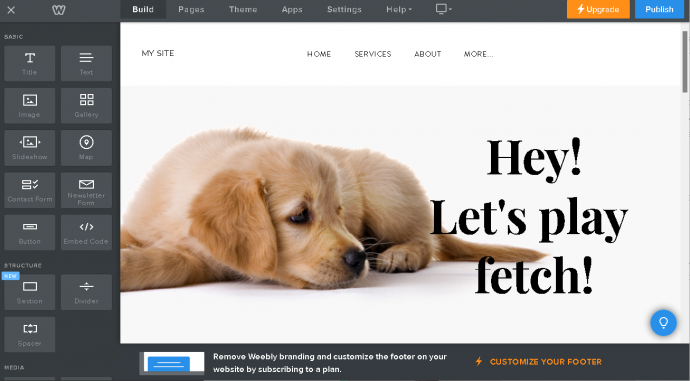
Adding pages is simple, and pages are automatically linked properly (and appear in menus, as you’d expect). You don’t have quite as much leeway in design as you do with Duda, but none of our testers could come up with a viable use case in which we would need that extra design leeway.
Weebly has all of the standard widgets that you would expect, but it doesn’t have some of the more specialized ones (like menu, for restaurants) built in. There are apps for these additional features, but we found them to be a bit disappointing compared to the ones built in to Duda.
Building a store with Weebly
Building an e-commerce site on Weebly now means you are pushed to use the Square tool to build a separate site. While the original Weebly tool retains some e-commerce functionality, it doesn’t have the latest direct integration with Square. Moreover, the integration between the original Weebly tool and the newer Square online tool is minimal, so you can’t build one site with both.
The Square tool for building an e-commerce site feels complicated. There isn’t an easy step-by-step process, and you’re quickly presented with a menu that can be confusing.
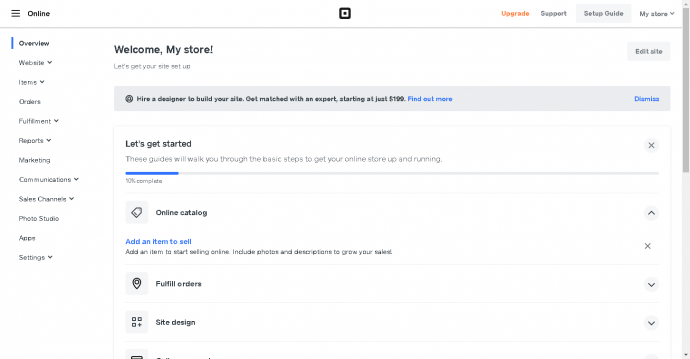
We didn’t like the fact that the Square tool doesn’t allow you to change much of the look and feel of the site, and that a lot of the great functionality of the original Weebly is missing from it.
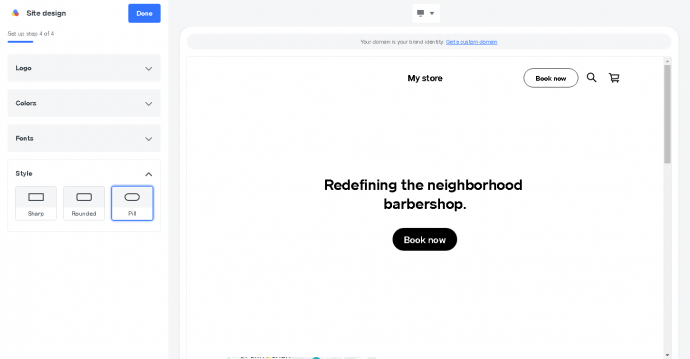
The nice part of the Square tool, however, is that it is perfectly integrated with the Square POS, meaning it’s constantly up to date and there is no complex import/export. This alone can be a reason for using it.
Wix: Ease of use
Wix starts off by asking you what kind of site you want to build, and it includes several options. Once you do that, you can choose one of a handful of designs.

From there, there are several selections, which lead to a GUI page builder. The GUI builder is really nice, and has dozens of different options for every block. However, new users may be a bit overwhelmed with the options. Our testers also found the Wix GUI builder to be a bit slow, taking several seconds to perform operations. This doesn’t seem so bad at first, but it can get frustrating if you’re building out a large website and making hundreds of little edits.
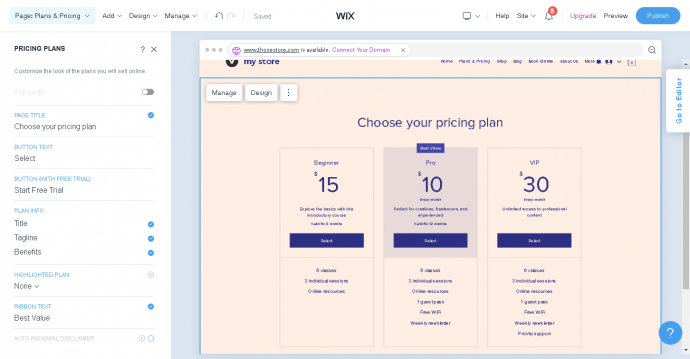
With the GUI page builder, you have complete control over look and feel. In fact, Wix has by far the most options for widgets, including hundreds of buttons, backgrounds, lightboxes, menu styles, and more.
However, with all of the options, can be difficult to create a good looking, cohesive design. Unless you’re an expert graphic artist, may end up with a hodgepodge, mishmash of widgets.
Wix has a Goldilocks problem — the drag and drop GUI gives you plenty of control, but building a really nice looking website with it can be difficult. In the next section, you will see what we created in a quick test — which isn’t quite as good looking as what we created with other tools.
Building a store with Wix
Surprisingly, building a store with Wix is much more straightforward than building a site. You are walked through the process step by step, beginning with adding products, then selecting a payment method, and choosing shipping.
There are plenty of options and settings, but the only import options is CSV.
5. WordPress vs Wix vs Weebly vs Duda: Quality
Regardless of whether you use WordPress, Duda, Wix, Squarespace, or Weebly, you’re bound to get a great quality website. However, some of these services produce slightly higher quality sites than others.
Which product creates the nicest designed sites? Which offer the most functionality? Let’s take a look.
WordPress: Quality
WordPress is by far the most stable and tested product on our roundup. You really can’t go wrong if you use it.
With WordPress.com you get access to the humongous library of themes and plugins available for WordPress. That means you can choose nearly any theme on Siteturner, or any of the major theme markets, and you should be able to use it for your site. The WordPress community has countless gorgeous themes available that fit any niche possible.
This extends to plugins, as well. You have a huge selection of plugins that you can use with just a quick installation, but you can also install the vast majority of open source WordPress themes on WordPress.com.
In all, this gives WordPress users near infinite customization, and the most features of any of the products in this review. However, doing any of this requires technical experience and knowledge of WordPress. If you have that, you likely host your own site, instead of using one of these services.
There are other downsides to using WordPress. We found the design quality of the built in themes to be a bit less impressive than some of the competitors. The themes available aren’t as eye-popping as Duda or Weebly, and there isn’t quite as much cohesion of design as there is on the other platforms.
Also, to use one of the beautiful 3rd party themes to their fulllest, you must import (or create) a complicated menu/post/category structure, which can be hard to do and time consuming.
Here’s a site we built in 5 minutes using WordPress:

WordPress store functionality
Because WordPress uses the tried and true WooCommerce plugin for stores, it has by far the most functionality of any of the products on this list. However, that comes with a significant cost. You will have to learn to set up and use WooCommerce, which is not for the faint of heart.
Moreover, WooCommerce forms will have to be styled separately, and likely won’t look good out of the box with the standard templates.
Duda: Quality
What really sets Duda apart from the others is its ability to create a beautiful and functional site with little work on your part.
Although it has fewer themes than some of its competitors, all of the themes fill a niche, and they’re extremely attractive. You’re bound to find a theme that fits your particular type of site. Each theme has beautiful transitions and tasteful CSS animation.
Duda has a bunch of cool widgets built in to the platform. These include an online scheduler, Yelp reviews, menus, social feeds, and much more. When you add any of these widgets to your site, it is styled to match the section of the site you add it to, meaning you won’t have a mismatch of fonts or colors.
There is also a lot of support for editing and/or inserting your own HTML code, if you want to modify the design in a way that is not supported by the editor. Of course, this is for advanced users only.
Duda has a lot of great functionality built in, so even though it doesn’t have a third party app market like the rest of the products here, you won’t miss it. There is excellent support for social media, including automatically syncing content. And it can even pull in content automatically by scraping your existing website.
Some of the other features you get include built in analytics and Google Analytics connectivity, and even white label functionality (if you’re an agency, and you want to resell the site builder).
Duda is designed for teams and agencies, so there are plenty of multi-user and project management tools. Most of us will never need to use those features, but they’re there in case you do.
Here is a screenshot of a site we created in 5 minutes with Duda:

Duda store functionality
Duda has everything you need for light eCommerce stores built right in. You don’t have to worry about plugins — it’s all integrated. And each theme is designed to seamlessly provide eCommerce functionality, like shopping carts and checkout forms.
There are several features that Duda has bulit-in, which no competitor has, including automatic marketing on Facebook, Google Shopping, eBay, and Amazon.
Weebly: Quality
As we described above, Weebly is now split into two product lines.
The original Weebly tool, like Duda, allows even the least artistic of us to build a gorgeous site. The themes that it offers are of extremely high quality, although there are not as many of them as we would have liked.
Each original Weebly original design is extremely crisp and clean, and the elements are laid out in a way that is intuitive, so your end user won’t have trouble with your site design. When you add additional widgets to your site, they are laid out well, and they never seem to look like they’re out of place.
In our opinion, Weebly does the best job of ensuring that you can’t mess up your site design. Whenever you add widgets, they are styled (colors, fonts, shape) to look proper on the section of the page where you place them. The Weebly editor arranges content very nicely, and when you add a widget, other widgets are moved accordingly, and the margins and padding are set so that everything looks like it belongs.
Aside from looks, Weebly offers a standard set of features, with hundreds of excellent third party apps to complement them. Most of the plugins are either free, or have a free version available.
One gripe we have: the themes that are offered with Weebly don’t cover as many niches as those of their competitors. For instance, there is a restaurant theme, but there are no bakery themes. So you may have to use a theme that doesn’t perfectly fit your business.
Here’s a screenshot of a site we built in 5 minutes using the original Weebly tool:

Weebly store functionality
You can still build a store with the original Weebly tool, but many of the features are now a bit hidden (and they lack the new integration features that the Square tool has).
For e-commercce, you are now pushed to build a site using the Square website builder tool. That tool feels very restrictive, and you don’t have the ability to change the design much from their standard site design.
After building a site with it you will get something that looks like this:

The result of building a site with the Square tool looks like this.
Wix: Quality
Wix gives you significant latitude to build what you want. There are numerous settings for every widget, and hundreds of apps that will allow you to do nearly anything (although their cost and support level may vary).
Wix also has some cool features like a comprehensive membership module, which essentially allows you to turn your Wix site into a social media site, with users, profiles, posts, messages, and more.
Wix also has a complete third party analytics tool, so you get good quality analytics information, even if you don’t use Google Analytics.
There are some places where Wix lags behind the competition, however. First, there are no good export options, so if you build on Wix, you’re kind of stuck there. It’s nice to be able to export content if you outgrow Wix and want to move to a dedicated platform.
More importantly, however, is the design. Although the majority of the templates are really nice, there is a lot of room for user error in building a complete site. When adding widgets, you can just drag and drop totally mismatched items onto a page.
For someone with strong artistic senses, none of this is a problem; however, those of us with terrible feel for design can easily end up with something that doesn’t look perfect. Over time, Wix has gotten much better in this regard. Unfortunately, it’s still not perfect.
Here’s a screenshot of a site we built in 5 minutes using Wix:


Wix store functionality
Wix’s store solution has an excellent feature set, including product customization and automatic rate calculation. It has the largest set of built in payment processors, and plenty of tools available. However, it’s not quite as easy to use as Duda or Weebly, and it’s not quite as functional as WooCommerce on WordPress.
6. Weebly vs Duda vs WordPress vs Wix: Pricing
Prices are per month, billed annually, unless otherwise noted.
WordPress |
Wix |
Duda |
Weebly |
|
|---|---|---|---|---|
| Try it | Try it | Try it | Try it | |
| Most basic paid plan | $4/mo
|
$16/mo
|
$14/mo
|
$6/mo
|
| Lowest priced plan for a usable business site | $25/mo
|
$27/mo
|
$14/mo (see above) | $12/mo
|
| Lowest priced eCommerce plan for an average-sized store | $45/mo
|
$27/mo
|
$22/mo + $19.25/mo eCommerce package
|
$26/mo
|
7. So what’s the best value?
So what’s the best value? In previous years, we had a complicated set of recommendations based on the type of website you’re building and several other parameters. However, we now have one clear winner:
And the winner is…Duda
For almost any user, at this point in the evolution of all of the tools, Duda just works the best. It’s the best looking, has a great rounded set of features, and doesn’t cost too much money.
Now of course, there is a little caveat. If you’re building a basic blog, WordPress can be cheap and easy. For $5/mo you can get a free domain and plenty of storage. However, you will still have the WordPress branding.
Also, if your business uses Square for a POS, Weebly’s Square-based e-commerce builder is fully integrated and always up to date. That makes management easier.
Recommendation |
|
|---|---|
| For a basic blog | WordPress $4/mo
|
| Best value for a small business site (without eCommerce) | Duda $22/mo
|
| Best value for eCommerce stores | Duda $22/mo + $19.25/mo eCommerce package
|
| Best high end option for consultants/agencies | Duda $33/mo
|